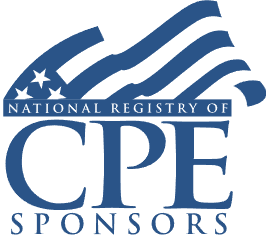Special Rules for Deducting Unused S Corporation Losses and Claiming Nontaxable Distributions
Measuring PTTP Under Treas. Reg. 1.1377-2, Increasing Stock Basis During PTTP, Treatment of Post-Termination Dividends

Course Details
- smart_display Format
On-Demand
- signal_cellular_alt Difficulty Level
Intermediate
- work Practice Area
Tax Preparer
- event Date
Thursday, November 21, 2019
- schedule Time
1:00 PM E.T.
- timer Program Length
110 minutes
-
BARBRI is a NASBA CPE sponsor and this 110-minute webinar is accredited for 2.0 CPE credits.
-
BARBRI is an IRS-approved continuing education provider offering certified courses for Enrolled Agents (EA) and Tax Return Preparers (RTRP).
-
Live Online
On Demand
This course will provide tax advisers and compliance professionals with a thorough exploration of the risks and opportunities of deducting unused S corporation accrued losses in the "post-termination transition period" (whether due to revocation of S election, winding down of the business, or a disqualifying event). The panelist will detail how the 2017 tax reform law changed the treatment of carryforward S corp disallowed loss amounts, strategies to maximize the tax advantages of making an S to C corp election and the Proposed Regulations issued November 2019 covering post-termination transition period distributions by eligible terminated S Corporations (ETSCs).
Description
Along with several provisions that adversely impact S corps, tax reform's permanent reduction in C corp income tax rates is leading many S corps to evaluate their entity choice and explore whether converting to C corp status will provide more tax benefits. Tax advisers must have a solid grasp of whether, when, and how to make an S corp revocation election to avoid costly tax consequences.
The law makes several changes to S corp income treatment that negatively affect some companies and their shareholders. Most notably, Section 199A's 20% pass-through deduction does not apply to specific trades or businesses. Some S corps may benefit from spinning off certain operations into C corps while retaining the S corp election for others.
The law also contains provisions that in many cases will allow shareholders of "eligible terminated S corporations" to treat dividends paid during the "post-termination transition period" (PTTP) as coming from the corporation's accumulated adjustment account or E&P more favorably than a typical dividend distribution from an operating C corporation. These distributions are tax-free to the extent of the shareholder's basis in the S corp stock.
Listen as Professor Robert W. Jamison, CPA, Professor Emeritus of Accounting at Indiana University, provides thorough and practical guidance to help advisers determine whether, when, and how to make a tax-efficient entity change from S corporation status to take advantage of the new tax reform law provisions.
Outline
- Prior treatment of unused S corp losses carried forward at the termination of S election or company operations
- Relief guidance
- Eligible termination events
- Measuring PTTP
- Treatment of losses suspended due to Section 465 at-risk limitations
- Increasing basis during PTTP
- Proposed Regulations on distributions made after S corp termination
Benefits
The panelist will discuss these and other important topics:
- The standards and events listed in Treas. Reg. 1.1377-2 for measuring an S corporation's PTTP
- Fixing carryforward losses potentially eligible to be freed-up at the beginning date of the PTTP
- How S corp shareholders may increase their stock basis during the PTTP to free-up previously disallowed losses
- Tax treatment of distributions made during PTTP
NASBA Details
Learning Objectives
After completing this course, you will be able to:
- Identify how to measure the PTTP
- Discuss how the post-tax reform relief provisions can allow an S corp shareholder to deduct suspended losses
- Discern the treatment of distributions made during the PTTP
- Recognize permissible methods of increasing the shareholder's basis in the S corporation during the PTTP to free-up suspended carryforward losses
- Field of Study: Taxes
- Level of Knowledge: Intermediate
- Advance Preparation: None
- Teaching Method: Seminar/Lecture
- Delivery Method: Group-Internet (via computer)
- Attendance Monitoring Method: Attendance is monitored electronically via a participant's PIN and through a series of attendance verification prompts displayed throughout the program
- Prerequisite: Three years+ business or public firm experience at mid-level within the organization, advising and working with corporations and pass-through entities. Specific knowledge of the tax treatment and operational benefits of C and S corporations, tax treatment of corporate dividends, and revoking an S corporation election; familiarity with accumulated adjustment accounts, earnings and profits and the treatment of dividends paid during the post-termination transition period (PTTP).

Strafford Publications, Inc. is registered with the National Association of State Boards of Accountancy (NASBA) as a sponsor of continuing professional education on the National Registry of CPE Sponsors. State boards of Accountancy have final authority on the acceptance of individual courses for CPE Credits. Complaints regarding registered sponsons may be submitted to NASBA through its website: www.nasbaregistry.org.

Strafford is an IRS-approved continuing education provider offering certified courses for Enrolled Agents (EA) and Tax Return Preparers (RTRP).
Unlimited access to premium CLE courses:
- Annual access
- Available live and on-demand
- Best for attorneys and legal professionals
Unlimited access to premium CPE courses.:
- Annual access
- Available live and on-demand
- Best for CPAs and tax professionals
Unlimited access to premium CLE, CPE, Professional Skills and Practice-Ready courses.:
- Annual access
- Available live and on-demand
- Best for legal, accounting, and tax professionals
Unlimited access to Professional Skills and Practice-Ready courses:
- Annual access
- Available on-demand
- Best for new attorneys
Related Courses
Recommended Resources
How CPE Can Bridge the Gap Between What You Know and What You Need to Know
- Career Advancement
